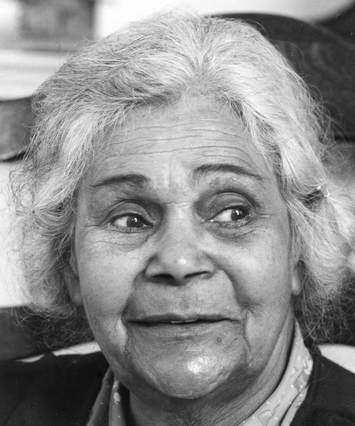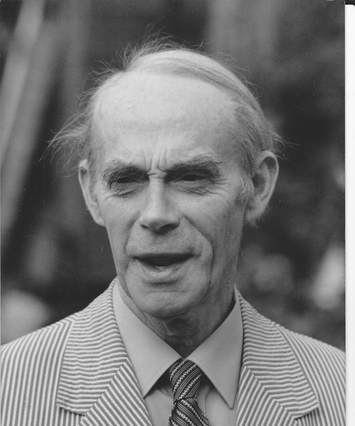“If Everyone Cared” - Margaret Tucker’s story. Peter Thwaites, 6 December 2021 (Zoom talk)
An important experience for me this year has been the rediscovery of Margaret Tucker’s autobiography If Everyone Cared (Ure Smith 1977) - a book that I first read over 40 years ago, but at a time when people like me were less aware of indigenous Australians. I was certainly not unaware, but the focus has sharpened over those years.
THE ULURU STATEMENT FROM THE HEART
Most recently, like many Australians, I have been struck by hearing about the Uluru Statement from the Heart, agreed by a representative gathering of Australian Aboriginal leaders and thinkers. ‘From the heart’ means authentic. You feel the person or people behind the words. They are not just cerebral. Practical steps still need to be found, but the goal and the intent come from deep enough to be considered seriously. When I heard ‘from the heart’ it felt like a new epoch, a significant step forward in Australia’s indigenous self-understanding, and in the self-understanding of all Australia.
Likewise, Margaret Tucker’s book is a remarkable statement from the heart: authentic, humble, and persuasive.
I lived with this book for a period of several weeks, often returning to reread certain passages. It was like a new discovery in our current situation. Certain phrases or passages would stand out and I had to go back to mine them out of the text. I kept track of page numbers so as to be able to do this. The narrative is interspersed with thoughts and reflections. Some details are left out of the story, maybe out of discretion - but we get the drift without having to know every detail.
The Uluru Statement from the Heart calls for the establishment of an Indigenous ‘Voice’ to the nation and its parliament. What form this voice is to take is still not clear. But Australians have increasingly realised the yawning gap in our national consciousness because of the absence of the original Australians from that consciousness. Those of us whose families came from other parts of the world to occupy and colonise Australia and make it our new home were both unwilling and unable to see the reality of the people who already belonged to the land. We did not know how to see them or hear them. This incomprehension was on both sides. Today we have a fresh chance to look back and begin to understand, with the perspective of hindsight and historical studies.
HEARING THE VOICE
Where will Australia find the powerful new Indigenous voice to fill the gap in our national consciousness? As I thought about this I realised that I had started to hear the voice in the spirit and story of Margaret Tucker in her autobiography. It is also the voice of her beloved mother (to whom this book dedicated) and all her family members, her elders and friends, all with their own stories and life experiences. Margaret Tucker’s book gives us access to them as people and through them to the world of indigenous Australia. Today the voice is also heard in the voices of Australia’s increasingly articulate indigenous population. That population is partly full-blood Aboriginal and partly of mixed descent, but all with a strong awareness of indigenous heritage going back to the first Australians. And suddenly, Australians as a nation are starting to listen and perceive - another major shift.
The story told in the autobiography, of a mixed race Aboriginal girl and her family and their life in the Riverina society of the early twentieth century, allows a white European male like myself to see the Australia of my forbears from the point of view of the indigenous inhabitants, human beings like me.
MARGARET TUCKER’S CHILDHOOD AND ORIGINS
If Everyone Cared opens with the author revisiting the place where she had spent her childhood 60-70 years earlier: Moonahculla, a small, poor settlement on the Edwards River, a tributary of the Murray River near Deniliquin, and Cummeragunja where she also did some of her schooling.
She remembers a Moonahculla family who slept on the ground in all weathers ‘covered with threadbare blankets handed out by the government of those days... Tuberculosis was a terrible scourge then and accounted for the lives of many hundreds of Aborigines in our area... There was a carelessness, thoughtlessness and unkindness in the administration of Aboriginal affairs in those days, which is a great blot on the history of Australia. We seemed to be just like guinea pigs - for experimental purposes... One thing is certain. Our race should never have been allowed to dwindle, either through disease or through exploitation.’ (p.29)
The mother of that family had ten surviving children but others had died in infancy. At sunset the old woman would start to wail, remembering and saying the names of her dead children, while others, sometimes including the local missionaries, would listen in sympathy. (p.30)
Margaret regrets not having done more herself to care for the old people who looked after her and her sisters when they were growing up and when both her parents had to be elsewhere earning money. After she and other young people had left the neighbourhood she heard that her ‘old Auntie’ had died alone in the Deniliquin hospital without anybody’s knowledge. There had been an occasion earlier when Margaret suddenly thought of sending this old family friend 10 shillings, about half of her weekly earnings at that time. (p.156). ‘A letter came back promptly saying “God bless you, my girl, thank you”... She had been hungry and had no food, but when she got my letter with the ten shillings she went down the town and bought sausages, tea, sugar and vegetables and bones for her dogs who were her only company. She thanked me several times in that letter. I shed tears when I remember how neglected she was.... How many young folk selfishly or unthinkingly neglect their old loved ones who did without for [them].’
Early in the book she also tells the tragic fate of May, the sister closest to her. May was a shy, gentle and conscientious girl, who married a young shearer from Cummeragunga. Good money could be made in shearing and they planned to save for a house. But the husband fell victim to ‘the white man’s fire water, which gave Aborigines the courage to mix with white men over the hotel bar’. This indirect effect of white racial superiority led to May taking poison in her despair and dying as a result. Her son then also took to drink. (p.70)
On p.61 Margaret Tucker writes: ‘...When the Aboriginal youths were moved to the country towns and cities, the moral standards our old Aboriginal people had kept long ago were easily forgotten. The fascination of the white skin was too much.’
Her own family are of mixed descent. That story starts early. ‘My mother’s father, George Middleton,’ she writes (p.14), ‘was one of three fair-skinned babies born in his tribe. Their mothers had to keep them near their side for fear of their being spirited away. They were about three years of age before the tribe accepted them.’ Her mother’s mother was full-blood Aboriginal. (p.16)
When Margaret was aged 13 and May 11, (it must have been in 1917), they were suddenly taken from their school at Moonahculla by a policeman who had been told by the Aborigines Protection Board that the girls were to be sent to the Cootamundra Domestic Training Home. This was done against the explicit wishes of their parents and without reference to them. It was only because of swift action taken by their schoolteacher Mrs Hill, a white woman, that their mother was alerted to what was happening and was able to see her daughters before they were taken in the police vehicle. The separation was to last years. The incident caused outrage in the community but was standard practice by Australian authorities at the time.
When Robert Manne, editor of Australia’s leading conservative magazine Quadrant, read this account it became the starting point for his major public lecture, ‘The stolen generations’, in 1997. The same year saw Manne’s resignation from Quadrant after the Committee of Management failed to support his 8-year attempt to make the magazine less conservative and more broadly based.
From the Cootamundra home Margaret was sent to work for a family in Cheltenham, Sydney where she was treated with coldness and cruelty, almost like a slave. On one occasion her mistress took away a letter that had arrived from Margaret’s mother and did not allow her to see it for some weeks - at a time when Margaret was suffering severely from loneliness.
Margaret Tucker writes about the racial culture of Australia during her life with complete frankness yet without a personal axe to grind. In that sense she is not ‘political’ and comes across as straightforward and genuine. ‘From the beginning,’ she writes (p.16), ‘the white man - soldier, convict, explorer, squatter or trooper - let us face it, made use of the Aboriginal women. The part-Aborigine has come from these beginnings.’ It is a complex personal, social and historical picture. But Margaret Tucker’s conclusion and her message, repeated a number of times with great conviction, is clear: that the decisive factor is ‘not colour but character’. She has a loathing of blame and bitterness and tries to be as frank about her own faults and weaknesses as about other people’s.
The story of her marriage to a white man (p.157) - one of three who proposed to her - is full of pain in the early years because ‘I had not realised the heartache and shame an Aboriginal girl could bring to a white family in those days by marrying their son.’ But slowly she won their affection, finding that ‘real care and love can conquer’. Also, ‘they adored my little girl’. After her husband returned from his overseas service in World War II, however, she writes that they ‘drifted apart’. The little girl later as Mollie Dyer became a well-known foster mother for children in need: her own biography was published with the title Room for one more.
In the last 30 pages of If Everyone Cared Margaret Tucker tells the story of her meeting with the Australian ‘Moral Re-Armament’ group and what followed. This happened at a social evening in the Melbourne home of Alex and Meryl Jackomas, arranged through Aboriginal leader Bill Onus. (p.172) Aboriginal, Maori and white were present. Margaret asked one of them to speak about the work they all seemed to be interested in.
‘To my surprise a lady got to her feet... Her husband was a Wing Commander in the RAAF during the Second World War. Having thanked the host and hostess she went on: “I am glad to have the opportunity to say from my heart how sorry I am for my superiority as a white Australian, and for our treatment, as whites, of the Australian Aboriginal race. Would you please forgive?” She said further that she felt that dark and white Australians could work together to help make Australia the land that God meant it to be... by creating a pattern in the way we live. They were words I shall never forget. It was the first time I had heard such words said to us Aborigines. It touched my heart and the hearts of many there that evening. It was the beginning of a friendship between dark and white Australians. After that she had Aborigines to visit many times...That great woman, like a sister to me, has passed on now leaving her husband, Eric Roberts, who is known to Aborigines far and wide... I owe a lot to Bill Onus for the friendships I made at that time.’
From that time Margaret Tucker became an increasingly important part of the Moral Re-Armament team in Melbourne and Australia. As a senior Aboriginal Australian she and her family had a special voice which was needed to help bring change and reconciliation to societies around the world.
In 1957 for the first time in her life she attended an international conference in America, invited by the famous Aboriginal tenor Harold Blair. It was held at the Moral Re-Armament ‘Training Centre’ on Mackinac Island in the Great Lakes. This was an exciting but overwhelming experience. At her first meal she found herself sitting between ‘Commander So-and so’ and ‘Lord So-and-so’, with an African prince in impressive robes sitting opposite. After three weeks she had a strong desire to return to Australia and her family. Her roommate Lorna White, an Australian nurse, suggested asking for God’s guidance. They sat by the lake in silence and to her surprise Margaret had the thought: ‘Stay long enough’(p.184). She finally stayed for eight months and had many dramatic and amusing adventures. She quotes the message given her by Frank Buchman, the founder and leader of MRA: ‘The destiny of the Australian Aborigine is to live so that he recalls the white man to his faith. You and your people will be the re-makers of the world.’
On the way home the Australian party visited the Philippines, where another international conference was being held, largely focussed on the theme of reconciliation between the Filipinos and their recent wartime enemy, Japan.
All these experiences added a global dimension to Margaret Tucker’s life and thinking. Near the end of the book she writes (p.200): "...One day it hit me... our people, the Aborigines, are people, not separate specimens. We are humans and have the same human nature... as any other race. There is a mighty way we can all, no matter what our colour, fight with courage and sincerity... to put right what is wrong in our countries...’
Some of the people she met at that time are people I remember from my student years in Melbourne in the 50s and 60s where I was also part of the MRA team. For two years from 1962 our family of six shared Eric and Jean Roberts’ big home ‘Wirraway’ in Kew.
In 1959 my father Michael Thwaites was one of a party who travelled to Cummeragunja for the burial of Margaret Tucker’s mother Theresa Clements. On that occasion he wrote the poem ‘Yarmuk’ (meaning ‘Mother’ or ‘Auntie’) which I later saw as a poster in the Redfern Aboriginal Medical Service.
Later I was living in Sydney with my family and working full time with Moral Re-Armament. In 1980 we organised a large international conference held at the Women’s College and asked Margaret Tucker to give the main speech on Australia Day, to an audience of several hundred. She began her speech ‘I happen to be an Aboriginal...’ and ended: ‘Colour now is not the issue, it is character; and what we give to the world as a people, black and white together - equal Australians. Certain people say to us Aborigines: “This country was yours.” I say, “True. But it is more than that. It is the world’s.”’
As well as the historical insights and remarkable encounters it is the simple human experiences, the failures and struggles that tell us most. Margaret Tucker repeatedly returns to the things she learnt from the old Aboriginal elders, from her mother and the Christian missionaries she knew in her youth. Those teachings remain guideposts, even - or especially - when we fail. The spiritual wisdom of Margaret Tucker and Aboriginal elders like her seem to me a guarantee that the Indigenous Voice called for in the Uluru Statement from the Heart will continue to grow in power as Australians learn to listen.
PETER THWAITES
Reference: Uluru Statement from the Heart: https://fromtheheart.com.au/explore-the-uluru-statement/
Reference: On the ‘Aboriginal Victoria’ website (Name now being changed to ‘First Peoples - State Relations’): Link: https://www.firstpeoplesrelations.vic.gov.au/margaret-tucker-mbec
PS If Everyone Cared is now out of print and hard to find. It contains striking pictures, including one of Theresa Clements and her four daughters. But it can be read online here: https://www.foranewworld.org/material/publications/if-everyone-cared
English



